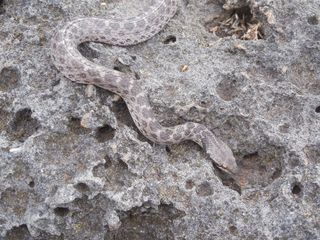
A mysterious species of snake has been rediscovered lurking in volcanic rocks on an island off Mexico
The elusive, nocturnal Clarion nightsnake was first discovered more than 80 years ago on Clarion Island, but was then lost to science.
"The rediscovery of the Clarion nightsnake is an incredible story of how scientists rely on historical data and museum collections to solve modern-day mysteries about biodiversity in the world we live in," lead author Daniel Mulcahy, a researcher at the National Museum of Natural History, in Washington, D.C., said in a statement. "Proper identification is the first step toward conserving this snake, and we plan to continue monitoring this species to learn more about the role it plays in the delicate Clarion Island ecosystem." [Image Gallery: Snakes of the World]
In 1936, naturalist William Beebe first unearthed a lone nightsnake, dubbed Hypsiglena ochrorhyncha unaocularus, on Clarion Island, which is one of the four Revillagigedo Islands in the Pacific Ocean. The reptile's speckled, brownish-black camouflage blended in with the black lava rock on the island, making it difficult to spot.
That single snake specimen was tagged and kept in the collections of the American Museum of Natural History in New York, but because no other researchers had seen the snake since, its existence as a separate species was questioned. In part, the snake, which grows to about 18 inches (45 centimeters) long, has remained hidden for decades because of its coloration — dark spots on its head and neck act as camouflage — and secretive behavior; the island itself is so remote that biologists can only access it with a military escort, limiting how many scientists actually searched for these reptiles.
But in 2013, Mulcahy and colleagues at the Instituto de Ecología in Mexico set out on a quest to the Revillagigedo Islands to find the missing species.
The team uncovered 11 of the elusive snakes, all on the volcanic island of Clarion. DNA testing confirmed the snakes were a distinct species from mainland nightsnakes.
Sign up for the Live Science daily newsletter now
Get the world’s most fascinating discoveries delivered straight to your inbox.
Their closest relatives inhabit a region on the border of Sonora and Sinaloa in Mexico, as well as an island off Mexico called Isla Santa Catalina in the Gulf of California. The new species may have first made it to the island by swimming across the sea from a river basin in Sonora, the researchers speculate.
Right now, the population seems to be stable, but bands of feral cats, an invasive species, on nearby islands could spell trouble for the snakes. The cats prey upon the nightsnake's main food source, an island lizard.
The snake was described Friday (May 16) in the journal PLOS ONE.
Follow Tia Ghose on Twitter and Google+. Follow Live Science @livescience, Facebook & Google+. Original article on Live Science.

Tia is the managing editor and was previously a senior writer for Live Science. Her work has appeared in Scientific American, Wired.com and other outlets. She holds a master's degree in bioengineering from the University of Washington, a graduate certificate in science writing from UC Santa Cruz and a bachelor's degree in mechanical engineering from the University of Texas at Austin. Tia was part of a team at the Milwaukee Journal Sentinel that published the Empty Cradles series on preterm births, which won multiple awards, including the 2012 Casey Medal for Meritorious Journalism.
Most Popular





